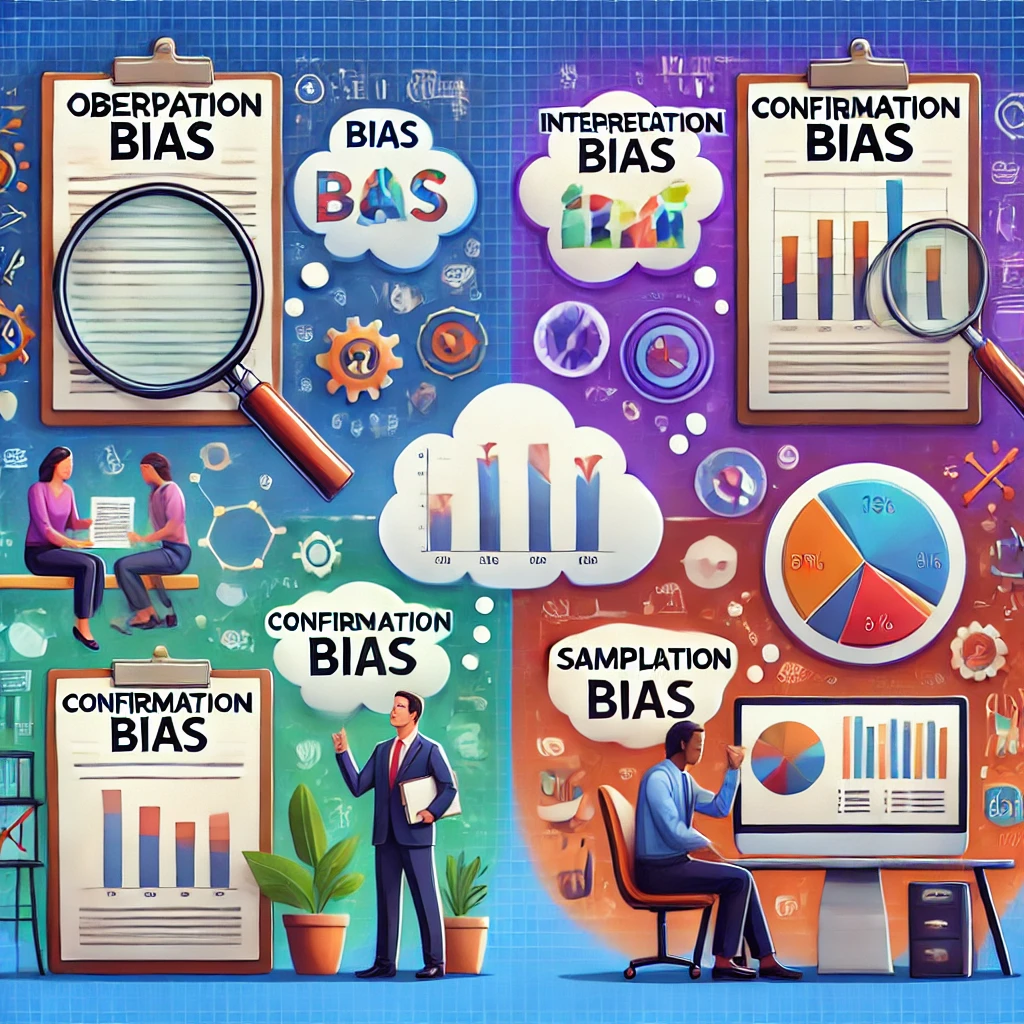Bias is a critical challenge in data analysis, as it can distort results, lead to incorrect conclusions, and impact decision-making. Among the many types of bias, observation bias, interpretation bias, confirmation bias, and sampling bias are particularly significant. In this article, we’ll explore these biases, how they arise, and provide practical examples to illustrate their impact.
1. Observation Bias
Definition: Observation bias occurs when the act of observing or recording data is influenced by the observer’s expectations or beliefs. It is also called the Hawthorne effect in some contexts, where individuals modify their behavior because they know they are being observed.
Example:
- Scenario: A researcher studying employee productivity notices that workers are more efficient when they are aware they’re being monitored.
- Impact: The observed behavior does not represent normal productivity levels, leading to an inaccurate understanding of employee performance.
Mitigation:
- Use blind observations where participants are unaware of being observed.
- Automate data collection using tools to reduce human influence.
2. Interpretation Bias
Definition: Interpretation bias happens when the analyst’s expectations, assumptions, or preferences influence how they interpret the data.
Example:
- Scenario: A data analyst analyzing survey results on customer satisfaction finds a slight increase in positive feedback. Because they expect a new product to be well-received, they overemphasize this trend and ignore negative feedback.
- Impact: The conclusion overstates customer satisfaction and may lead to misguided decisions.
Mitigation:
- Have multiple analysts independently interpret the data and compare results.
- Use predefined criteria for interpreting data to minimize subjective influence.
3. Confirmation Bias
Definition: Confirmation bias occurs when individuals focus on information that supports their pre-existing beliefs or hypotheses while ignoring contradictory evidence.
Example:
- Scenario: A marketing team believes a new advertising campaign will boost sales. During analysis, they highlight regions with increased sales while ignoring regions where sales declined.
- Impact: The campaign is deemed successful without a complete evaluation, potentially wasting resources on ineffective strategies.
Mitigation:
- Design studies to test alternative hypotheses rather than confirming a single belief.
- Encourage peer reviews to identify overlooked or ignored data.
4. Sampling Bias
Definition: Sampling bias arises when the sample data used for analysis is not representative of the overall population.
Example:
- Scenario: A health survey conducted exclusively in urban areas concludes that most people have access to quality healthcare, ignoring rural populations with limited access.
- Impact: Policy decisions based on this survey may exclude underserved rural areas, perpetuating inequalities.
Mitigation:
- Ensure the sampling method includes diverse and representative groups.
- Use random sampling to minimize unintentional exclusions.
Practical Consequences of These Biases
Biases can have significant practical consequences:
- Observation Bias: Overestimated productivity may lead to unrealistic expectations in workplace policies.
- Interpretation Bias: Misinterpreted customer satisfaction data can harm product improvements or marketing strategies.
- Confirmation Bias: Unchallenged assumptions can result in flawed decisions and wasted resources.
- Sampling Bias: Misguided policies or recommendations can arise from unrepresentative data.
How to Address Bias Holistically
To minimize the impact of these biases:
- Diversify Data Sources:
- Use multiple data collection methods and sources to cross-verify findings.
- Standardize Procedures:
- Use standardized methods for observation, interpretation, and sampling.
- Encourage Collaboration:
- Involve multiple stakeholders or analysts to reduce individual bias.
- Apply Statistical Methods:
- Use techniques like weighting to adjust for sampling bias.
- Document Assumptions:
- Clearly document assumptions to ensure they are critically evaluated.
Conclusion
Biases like observation, interpretation, confirmation, and sampling bias can significantly impact data quality and insights. Recognizing these biases and taking proactive steps to mitigate them ensures more accurate and reliable analysis. Analysts can deliver more meaningful and actionable results by fostering awareness and applying rigorous methods, ultimately driving better decisions.
